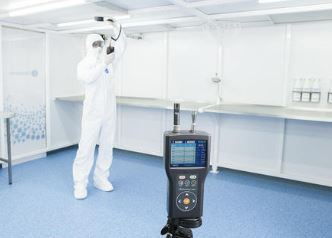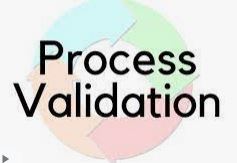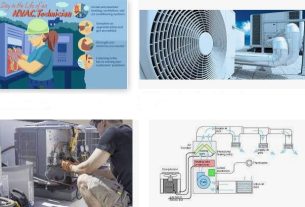In this article, we will discuss HVAC System Validation.HVAC Validation is required for pharmaceutical cleanroom validation. following tests are performed for validation.
Page Contents
1.0 Air Flow Pattern
1.1 Take the titanium tetrachloride stick.
1.2 Burn the stick.
1.3 Place the burning stick in front of the running Air Handling Unit (AHU).
1.4 Observed the flow of air with the help of smock distribution in the room.
1.5 Make chart diagram of flew of air in the room.
2.0 Air Flow Velocity And Change Per Hour
2.1 Scan the area of the HEPA Filter, with the anemometer probe, 6 inches from the filter face.
2.2 For the case of the experiment, divide the area of the HEPA Filter into four equal, hypothetical grids.
2.3 Record the velocity readings taken at the center of the grids, and at the junction of dividing lines (center of HEPA Filter) in 5.5.
2.4 Calculate the Average Velocity (V in feet per minute ) as :
V = (V1+V2+V3+V4) (Eq.1)
4
Vi = Velocity observation at each point
2.5 Measure the dimensions of each air inlet i.e. HEPA Filter, in feet and record it.
2.6 Calculate the Area (A in square feet) of each Air inlet as the product of the length and the width as :
A = l x w (Eq.2)
where l = length of the inlet
w = width of inlet
2.7 Calculate the Total Air Volume (T in cubic feet per minute) supplied in each zone, by using the formula :
T = A x V (Eq.3)
where A = Area of particular Air inlet in square feet
V = Average air velocity at particular air inlet in feet per minute
2.8 Calculate the total volume of the room by multiplying the length of the room, a breath of room, and height of the room.
Volume = L x B x H
2.9 Total air change is divided by the total volume of the room will give the air change per hour. Fill the record in the form as annexure-II.
3.0 Filter Leak Test
3.1 Place the velometer at the front of the AHU unit.
3.2 Check the velocity of air to all corners of the AHU. The air velocity should be within the higher limit of the HEPA filter.
3.3 If there is air velocity is more than the higher limit changes the gas cut to prevent air leakage.
4.0 Particles Count
4.1 On the air system before one hour of test operation. Take the suitable particle counter and operate it to check the particles in the room during a nonworking operation.
4.2 Collect the information from the particle counter and fill them in the format.
4.3 Operate the particle counter when work is in progress in the area. The particles should be count when more than one hour of work has been progressed in the area. Record the data in the format.
4.4 Operate the particle counter for all the room maintaining grade A, grade B, grade C & grade D.
5.0 Viable Monitoring
5.1 Expose Plate Count Agar and Saboraud Dextrose Agar media plates in sterile manufacturing area (Fabrication, Vial Filling, Vial Sealing & Sterile passage) as per location plan given on the back of the paper sheet. Similarly, exposing the plates in Change Room II and III and Degowning I twice a week and once a week in Vial Washing, Bung Washing, and Component Preparation.
5.2 Monitor the microbial load on the surface of the sterile manufacturing area by swab sampling and testing follow the SOP. Carry out swab sampling daily in Vial Filling, Vial Sealing, Sterile Buffer, and Blending III; and twice in a week in Sterile Passage, Change Room II, Change Room III, and Degowning I. Similarly carry out the swab sampling once in a week in Change Room I, Degowning II, Vial Washing, Bung Washing, and component preparation. Record the results.
5.3 Place the media strips or Petri dishes in the air sampler on operating the air sampler as per the standard operating procedure of the equipment.
5.4 Record the data in the format.
5.5 Monitor the microbial load on the surface of hand gloves of the operators daily once in each working shift at random during activity follow the SOP and record the result. Record the data in the format.
5.6 In case of repeated failure during two observations the corrective action shall immediately be planned and implemented.
5.7 Monitor the critical functions of the HVAC system, Water System, and personnel’s behavior in sterile and investigate the cause of adverse results immediately after observation.
6.0 Filter Integrity Test ( DOP/PAO Test)
6.1 Generate DOP/PAO Aerosol using Aerosol generator, by subjecting DOP/PAO to 20 psi air pressure. Direct test aerosol at the supply duct in the Air Handling System.
6.2 Switch the photometer “ON” and allow it to stabilize for five minutes.
6.3 Ensure that 100 % upstream concentration is achieved at all the terminal HEPA filters.
6.4 Scan the filter matrix and perimeter bypassing the receptor probe 1 inch from the filter surface, in overlapping strokes traversing at approximately 10 fpm to check for leaks, if any.
6.5 Test all the HEPA filters as per the above steps and record the observations in the format.
7.0 Pressure Difference
7.1 Attached all concerning room (Under Test) to the manometer which is attached to the wall of the adjacent area.
7.2 On the air system inside the tested area and wait to stabilize the pressure in the area.
7.3 Observed the pressure difference from all rooms and from room to room.
7.4 Record the data in the format.
8.0 Recovery (Temperature & Humidity)
8.1 Off the HVAC system and checked the humidity of the area.
8.2 If the humidity of the area within specification. Increase the humidity by spraying hot water in the area up to 75%.
8.3 Wait to stabilize the humidity in the area by about 75%.
8.4 Operate the HVAC system and note the time. Wait to stabilize the humidity in the area within the specification limit.
8.5 Note and record the time in the format.
8.6 For the recovery test increase the temperature of the area by using a hot air blower in the area and increase the temperature to 40C.
8.7 Operate the HVAC system and note the time. Wait to stabilize the temperature in the area within the specification limit.
8.8 Note and record the time in the format.
9.0 Temperature
9.1 Place the calibrated thermometer in a different location.
9.2 Operate the HVAC system and note the time. Wait to stabilize the temperature in the area within the specification limit.
9.3 Check and record the temperature of the area in format.
9.4 Place the calibrated hygrometer in different locations.
9.5 Operate the HVAC system and note the time. Wait to stabilize the humidity in the area within the specification limit.
9.6 Check and record the temperature of the area in format.
10.0 Fresh Air Determination
10.1 On the concerned AHU and wait to stabiles the air pressure in the room.
10.2 On the fresh air dumper for fresh air and observed and calculate the intake air by the dumper in the room. Observed and calculate the total air change in the room.
10.3 The intake of fresh air is divided by the total air change in the room and multiply by 100 to calculate the % fresh air intake on each cycle by the HVAC system in the tested room.
10.4 Record the data in the performance format record.
if you have any comment/suggestion about this article ” HVAC System Validation” then do write to us.


